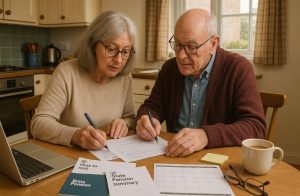Table of Contents
ToggleA Historic Oversight: Why Thousands Are Owed Up to £8,377 in Back Payments?
In a significant development affecting thousands of pensioners, the Department for Work and Pensions (DWP) and HM Revenue and Customs (HMRC) have identified a long-standing administrative error in State Pension calculations.
The issue stems from missing Home Responsibilities Protection (HRP) data in National Insurance (NI) records, which affected the State Pension entitlement of many individuals, particularly women who took on caring responsibilities between 1978 and 2010.
The HRP scheme was designed to ensure that parents and carers mostly women were not penalised in their pension eligibility due to time spent away from formal employment. However, a failure to properly record these periods has resulted in underpayments of the State Pension for years, and in some cases, decades.
Since the discovery, a joint correction initiative between the DWP and HMRC has been underway. Between January 2024 and March 2025, the government has identified 12,379 underpayments totalling £104 million, with an average payout of £8,377.
These underpayments primarily affect women in their 60s and 70s, many of whom received letters encouraging them to check their pension entitlement.
For those affected, this could be a crucial opportunity to reclaim lost income. Furthermore, surviving relatives of deceased individuals who were underpaid may also lodge claims.
Understanding Home Responsibilities Protection (HRP)

Home Responsibilities Protection was introduced in 1978 to safeguard State Pension eligibility for individuals caring for children or vulnerable adults. The scheme reduced the number of qualifying years needed for a full pension by awarding NI credits for each eligible year.
Between 1978 and 2010, HRP was meant to be applied automatically in many cases, particularly for parents receiving Child Benefit. However, records indicate that HRP was often omitted due to technical failures, including the absence of a recorded National Insurance number.
The HRP scheme was replaced in April 2010 by a more structured system of NI credits, which improved automatic recording. Nonetheless, the oversight for the 32-year period before this remains a significant concern and is being addressed by the ongoing corrections initiative.
Who Was Affected and How to Check Eligibility?
The DWP has confirmed that those most likely affected are women who:
- Claimed Child Benefit for children under 16 between 1978 and 2010
- Cared for disabled or sick relatives and were in receipt of Income Support
- Worked as foster or kinship carers (especially in Scotland)
- Did not include a National Insurance number when submitting relevant benefit claims before May 2000
Not everyone affected by the error will have been underpaid, as some may already have full qualifying years or other pension benefits.
However, those who suspect they may be affected are urged to check their National Insurance records via the HRP checker tool on GOV.UK. The online process is available even for those above State Pension age, and relatives can claim on behalf of deceased pensioners.
DWP Correction Process and Ongoing Communication

To date, over 370,000 letters have been sent by HMRC to individuals who may have missing HRP years. The correction process is part of the Legal Entitlements and Administrative Practice (LEAP) programme, a systematic review designed to ensure historical fairness.
The DWP is currently processing approximately 2,000 claims per month, with a target to complete the review and issue payments by the end of 2025.
The initiative includes not only recalculations of State Pension amounts but also backdated payments for eligible years, which can go as far back as the late 1970s.
Projected Increases to the State Pension in 2025
In addition to correcting past mistakes, the State Pension system is due for routine updates in April 2025 under the triple lock mechanism. This ensures pensions rise annually by the highest of inflation, average earnings growth, or 2.5%. Due to high inflation and wage growth in 2024, the following projections are anticipated:
| Pension Type | 2024–25 Rate | Estimated 2025–26 Rate |
| New Full State Pension | £221.20 per week | £233.50 – £238.00 per week |
| Basic State Pension | £169.50 per week | £178.00 – £181.00 per week |
These increases aim to offset the rising cost of living and provide pensioners with improved financial stability.
National Insurance and Pension Entitlement
National Insurance contributions are at the heart of State Pension eligibility. To receive any State Pension, individuals must have at least 10 qualifying years of NI contributions. For the full new State Pension, 35 years are required.
Voluntary contributions can be made to cover gaps in one’s NI record. The addition of HRP years, if applicable, can also significantly improve a pensioner’s qualifying total. People are encouraged to review their NI records regularly to identify and correct any gaps.
Pension Credit: A Lifeline for Thousands Still Unclaimed

Pension Credit remains one of the most underutilised benefits among UK pensioners. Currently, about 1.4 million pensioners claim Pension Credit, but the DWP estimates that nearly 760,000 more are eligible but have not yet applied.
Pension Credit is a means-tested benefit that tops up income to a minimum level. As of 2025:
- Single pensioners are entitled to at least £227.10 per week
- Couples are entitled to £346.60 per week combined
Many pensioners mistakenly assume that savings or home ownership make them ineligible. However, even minimal Pension Credit entitlements can unlock additional benefits such as:
- Free TV licence for over-75s
- Housing Benefit or Council Tax support
- Winter Fuel Payment and Cold Weather Payments
- Discounts on NHS charges
Applications can be made via GOV.UK or by calling the Pension Credit helpline on 0800 99 1234.
Summary of 2025 Pension Developments
| Issue | Description |
| HRP Underpayment Correction | Ongoing DWP/HMRC initiative correcting missed HRP records |
| Average HRP Back Payment | £8,377 |
| State Pension Increase | Expected to rise by over £10/week under the triple lock |
| Pension Credit | Available to low-income pensioners with unclaimed entitlements |
| Triple Lock Guarantee | Continues to ensure pensions rise with the cost of living |
Action Steps for Pensioners

To make the most of the DWP changes and correct any historical oversights:
- Use the HRP eligibility tool if you cared for someone or received Child Benefit between 1978 and 2010
- Review your National Insurance record for gaps and request a correction if needed
- Apply for Pension Credit if your income is below the threshold
- Plan for the April 2025 State Pension increase and adjust your retirement finances accordingly
- Encourage relatives to check eligibility, especially for deceased family members who may have missed out
Frequently Asked Questions
How can I check if I’m owed a State Pension back payment?
You can use the HRP eligibility tool on GOV.UK to review your National Insurance record. If eligible, follow the guidance to submit a claim.
What is Home Responsibilities Protection (HRP)?
HRP was a scheme to protect carers’ and parents’ pensions by crediting their NI record between 1978 and 2010.
Are HRP claims still valid if the pensioner has died?
Yes, relatives or representatives of deceased individuals can apply for arrears if the individual was underpaid.
What changes are happening to the State Pension in 2025?
The State Pension is set to increase in April 2025 under the triple lock system. The full rate could reach up to £238 per week.
How do I know if I qualify for Pension Credit?
You can use the Pension Credit calculator on GOV.UK or call the helpline to check your entitlement based on income and circumstances.
What if I didn’t claim Child Benefit but cared for someone else’s child?
You may still qualify for HRP if you were a foster or kinship carer in Scotland and met eligibility criteria between 2003 and 2010.
Will the State Pension age change in 2025?
No. The State Pension age remains at 66 in 2025, but it is scheduled to rise to 67 by 2028.




